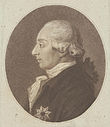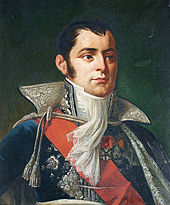Karl Ludwig von Lecoq
Karl Ludwig von Lecoq | |
|---|---|
| Born | 23 September 1754 General Officer |
| Battles/wars | French Revolutionary Wars Napoleonic Wars |
| Awards | Pour le Mérite (military order) |
| Other work | Chief, Grenadier Garde Infantry Regiment # 6 |
Karl Ludwig von Lecoq or Karl Ludwig von Le Coq, born 23 September 1754 – died 14 February 1829, of
Early career
Lecoq was born on 23 September 1754 to a
Joining the Riedesel Infantry Regiment Nr. 10 as a


After the
While performing his military duties, he began mapping
1806

Before the

Opposing them were King
On 9 October, columns under Lecoq and Hagken began marching west, though progress was slow. Ten days later, news of the catastrophic

Meanwhile, Napoleon gave Louis and Mortier the signal to advance. First, he directed their columns on the neutral state of Hesse-Kassel. Napoleon knew that William I, Elector of Hesse, though officially neutral, was pro-Prussian and he determined to depose him.[10] Mortier's 5,500 men and Louis' troops overran Hesse-Kassel, disarmed the Hessian army, and chased the elector into exile. On 9 November, Louis withdrew from the campaign in bad health, leaving Mortier in command of a 12,000-man corps. Starting on 7 October, French troops moved into the area of Hameln. By the 10th, a good part of Mortier's corps appeared before the city.[11]
By this time, Lecoq had the fortifications in good repair and manned them with about 10,000 troops. The city and fortress were well stocked with food and supplies and ready to sustain a siege. Mortier left 6,000 men to maintain the

Lecoq's 10,000 troops and 175 guns included a 3,058-strong garrison under the 75-year-old General-Major von Schöler. These troops comprised the 3rd battalions of the Schenck Infantry Regiment Nr. 9, Tschammer Infantry Regiment Nr. 27, Hagken Infantry Regiment Nr. 44 and Hessen Infantry Regiment Nr. 48. Two battalions of the Oranien Infantry Regiment Nr. 19 rounded out the garrison. The remainder of Lecoq's force consisted of four Invalid companies from the first four regiments, 40 hussars, 181 artillerists, 1,000 fugitives from Jena-Auerstedt and recruit drafts from the Treuenfels Infantry Regiment Nr. 29 and the Strachwitz Infantry Regiment Nr. 43.[14]
While these operations were in progress, Napoleon signed an armistice with the king's envoy Girolamo Lucchesini that specified that the remaining Prussian fortresses were to be surrendered. King Frederick William III later refused to sign the document, but that did not stop the French emperor from trying to exploit the tentative agreement. He sent Anne Jean Marie René Savary to Hameln with the information in an attempt to coax the garrison into laying down its arms. On 19 November, Savary arrived at Hameln and was granted a parley with Lecoq and his generals. Putting his diplomatic talent to good use, he reminded the generals that there was no Prussian field army within 400 kilometers. After he revealed the conditions of the armistice, Lecoq decided to capitulate. The surrender terms were similar to those at the Capitulation of Prenzlau in that officers were to be paroled and the enlisted men were to be made prisoners.[12]
When Lecoq's rank and file found out about the capitulation, a mutiny broke out and the soldiers forced their way into wine-shops and soon became drunk. Robbery, looting and other disorders followed. For their part, the officers demanded that they be paid and that their troops be paroled. There are two versions of what happened next. In one account, Savary turned his cavalry loose in the streets to drive the Prussians out of the city. Once outside the city they were surrounded and disarmed.[15] In the second account, 9,000 soldiers dispersed into the countryside in the confusion and only 600 were marched into captivity after the 22 November capitulation.[8][14][16] On 26 November, the fortress of Nienburg capitulated with its 2,911-man garrison.[17]
Historian Digby Smith called the surrender "shameful".[17] Francis Loraine Petre believed that Lecoq's situation was hopeless, but that it was his responsibility to hold out as long as possible. A long siege might have kept a substantial French force from being used in the winter campaign.[12]
Later career
In 1809, Lecoq faced an inquiry into the surrender of the fortress. Sentenced to life in prison, he was sent to Spandau. However, he was allowed to live mostly in the city rather than in a prison cell. In 1812, the king refused his request for clemency, though he was permitted to visit his estate in Pichelsdorf near Berlin. After Prussia joined the War of the Sixth Coalition in 1813, he was allowed to live in Oranienburg. In 1814 he was finally pardoned and took up residence in Berlin where he continued work on his beloved maps as his eyesight faded away. Lecoq's wife Marie Charlotte Lautier (b. 1760) died in 1826. The couple had four children, of whom two daughters survived until adulthood. Completely blind, Lecoq died in Berlin on 14 February 1829 and was buried in the French cemetery.[3]
Notes
- ^ a b c d e f Krauss 1969, p. 125.
- ^ Phipps 2011, pp. 304–305.
- ^ a b Grosser Generalstab: 1806. Das Preussische Offizierkorps und die Untersuchung der Kriegsereignisse. Berlin, 1906. p. 46
- ^ Petre 1993, p. 64.
- ^ Petre 1993, p. 68.
- ^ Petre 1993, p. 291.
- ^ a b c Petre 1993, p. 292.
- ^ a b Pigeard 2004, p. 269.
- ^ Petre 1993, pp. 292–293.
- ^ Petre 1993, pp. 293–294.
- ^ Petre 1993, p. 297.
- ^ a b c Petre 1993, p. 298.
- ^ Petre 1993, p. 299.
- ^ a b c Smith 1998, p. 233.
- ^ Petre 1993, pp. 298–299.
- ^ Winkler 1883.
- ^ a b Smith 1998, pp. 233–234.
References
- 1806. Das Preussische Offizierkorps und die Untersuchung der Kriegsereignisse (in German). Berlin: Grosser Generalstab. 1906.
- Gerardy, Theo, ed. (1959). Briefwechsel zwischen Carl Friedrich Gauß und Carl Ludwig von Lecoq. Abhandlungen der Akademie der Wissenschaften in Göttingen, Mathematisch-Physikalische Klasse, No. 4 (in German). Göttingen: Vandenhoeck & Ruprecht. pp. 37–63. (letters from February 1799 to September 1800)
- Krauss, Georg (1969). "150 Jahre preußische Meßtischblätter". Zeitschrift für Vermessungswesen (in German). 94 (4). Stuttgart: Verlag Konrad Wittwer: 125.
- ISBN 1-85367-145-2.
- ISBN 978-1-908692-25-2.
- Pigeard, Alain (2004). Dictionnaire des batailles de Napoléon (in French). Tallandier, Bibliothèque Napoléonienne. ISBN 2-84734-073-4.
- ISBN 1-85367-276-9.
- Winkler (1883), "Lecoq, Karl Ludwig Edler von", Allgemeine Deutsche Biographie (in German), vol. 18, Leipzig: Duncker & Humblot, pp. 108–109
